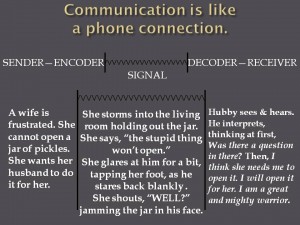Let’s be honest, when you understand what communication is at its roots, you’ll realize that you cannot avoid miscommunication… not altogether. It takes two to tango (That’s what my betters say, anyway… personally, I’m more of a Bugs Bunny Square Dance sort of fella’) and communication requires both a sender and a receiver.
You can, however, become a better communicator by paying better attention to 5 aspects of communication.
In Devito’s telephone circuit model[1] we can discern 5 basic parts of communication, any one of which can go horribly wrong.
One has the source… someone trying to communicate a “meaning.” This meaning is encoded using symbols deemed sufficient to stamp it into someone else’s mind—Words, combinations of words, nuanced selection of words, sounds and inflection, things, movement, and/or touch. The use of these symbols is a signal. Another receives this signal and must discern the meaning by decoding the symbols used. If, the decoder attaches the same meaning to the symbols as the encoder, voila, communication. (See Fig.1) If, however, the decoder attaches different meaning to the symbols than the encoder did… miscommunication.
Based on this model, sufficient for our purposes, miscommunication stems from one or more of five places, though the reasons for failure at any point may be manifold. If you work hard at preserving the integrity of each, you will avoid a lot of miscommunication.
Sender: What goes wrong with senders?
Problem: People can be confused about their own thoughts and emotions… uncertain what they themselves want to communicate. Even so, meaning stems from the sender’s intentions… always. Some things just don’t have discernible meaning.
Solution: Live a contemplative life, seeking self-knowledge, discerning the exact nature of what you want, and wish to convey. You cannot hope to be understood by others if you do not understand yourself.
Encoder: What goes wrong during encoding?
Problem: A sender can fail to anticipate the impress of his symbols on others. You can be ignorant of your own community’s use of a symbol, but you can also fail to anticipate how your intended receiver’s community would interpret your symbols. [2]
Solution: (1) Build your vocabulary and develop grammatical precision. Read and listen more with a curious nature, seeking to understand all that you see and hear. Be a life learner. (2) Know your audience and choose symbols based on how they will hear them. (3) Study cross-cultural communication to enhance your awareness of complex encoding-decoding situations.
Signal: What goes wrong with signals?
Problem: Anything that interferes with one’s ability to perceive a signal thwarts understanding. Bad hearing by a listener; a speakers poor annunciation; distractions like background noise, discomfort, or exhaustion in the receiver.
Solution: Strive, when able, to create advantageous environments. Pay attention to sound, color, lighting, comfort levels, time. Be sensitive to the condition of those with whom you wish to communicate.
Decoder: What goes wrong with decoding?
Problem: The problem with decoders is the same problem with encoders. A basic failure to know the meanings of symbols within one’s own community or a failure to understand the meaning of symbols within the sender’s community.
Solution: When you are the receiver, make sure you are attuned to every nuance of the sender’s symbols (language, inflection, posture, movement, expression) with a sensitivity to all the possible meanings that he might intend. Be sensitive to the possibility that the sender might be out of his element or community, and might be struggling with both himself and his symbols. A good receiver can expend more energy than a sender, needing to think farther afield seeking and weighing possibilities.
If you are not the intended receiver, apply historical, grammatical, literary hermeneutics through an inductive process in light of both the sender and the messages intended receiver. Long Live HAGALAH!!!
Receiver: What goes wrong with receivers?
Problem: Receivers fail most through attitude and prejudice. You must want to understand what someone is trying to communicate vs. wanting to argue or defeat him, or to manipulate the outcome of an encounter. Prejudice can easily defeat even the desire to understand because it casts dispersions on the sender, crowding out meaning with emotional response, coloring one’s ability to entertain certain ideas long enough to comprehend them.
Solution: When on the receiving end of communication, make a concentrated effort to understand what is being communicated before you react to what is being communicated. Meaning is rooted in the intentions of the sender. Discover what things mean to him or her before you ask what it means for you and yours. You have to want to understand.
[1] Devito, J. A. (1994) Human Communication: The Basic Course. New York; HarperCollins.
[2] The struggle of unintended receivers to understand a senders symbols is another issue altogether.
[3] media pic is from sxc.hu






